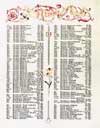In Memory ofGEORGE BUCHANLance Sergeant
|
| Additional Information: Click on images to view details |
George Buchan Yule was born at Weets, Kennethmont on 3rd June 1887. He was the illegitimate son of Mary Yule who advised on his birth certificate that she was a Domestic Servant domicile at Mains of Leask, Slains. In the 1891 Census George B Yule is a boarder aged three years in the home of the McDonald family at Weets Croft. It may be that his mother had a family link to this family. He started at Old Town School on 12/5/1893 and moved to Kennethmont School on 16/3/1899. In both records his DOB is given as 3/6/1887 and his Parent / Guardian as John McDonald, Weets. He is recorded in both registers as George Buchan. Service Notes When war was declared George Buchan was already a member of the local Militia regiment based in Vancouver, British Columbia, the 72nd Seaforth Highlanders of Canada. When the initial appeal for volunteers was made he joined, as an original member, the newly formed 16th Batt, Canadian Infantry on 23 September 1914 at Camp Valcartier (Québec). The 16th Batt was made up of Militia men from Vancouver and Victoria, British Columbia; Winnipeg, Manitoba and Hamilton, Ontario. He then went to France as a member of The Canadian Over-Seas Expeditionary Force. Attestation papers. Additional details from CEF Roll of Honour The 16th Battalion had been cobbled together from units in four other highland regiments. They were companies drawn from Vancouver's Seaforth Highlanders, the Gordon Highlanders of Victoria, Winnipeg's Cameron Highlanders and Hamilton's Canadian Highlanders. Circumstances of Death file: Died of wounds at No 10 C.C.S. 16th Battalion CEF ( Manitoba Regiment)
were known as The Canadian Scottish. 28th April 1916 3rd Brigade, 1st Canadian
Division. In Ypres area around Mount Sorrel. Urquhart, Hugh M. -- The history of the 16th Battalion : (the Canadian Scottish) Canadian Expeditionary Force in the Great War, 1914-1919. -- Toronto : Macmillan, 1932. -- 853 p. 1st Canadian Division 3 October 1914 the first contingent
of Canadian soldiers, 33,000 officers and men, the largest army
that ever crossed the Atlantic at one time, set sail from the
Bay of Gaspé. 3rd Canadian Brigade.
|
Commemorative Information
| Cemetery: | LIJSSENTHOEK MILITARY CEMETERY, Poperinge, West-Vlaanderen, Belgium |
| Grave
Reference/ Panel Number: |
VI. B. 23. |
| Location:
|
Lijssenthoek Military Cemetery is located
11.5 kilometres west of Ieper town centre, on the Boescheepseweg,
a road leading from the N308 connecting Ieper to Poperinge. From
Ieper town centre the Poperingseweg (N308) is reached via Elverdingsestraat,
then over two small roundabouts in the J. Capronstraat. The Poperingseweg
is a continuation of the J. Capronstraat and begins after a prominent
railway level crossing. On reaching Poperinge, the N308 joins
the left hand turning onto the R33, Poperinge ring road. The R33
ring continues to the left hand junction with the N38 Frans- Vlaanderenweg.
800 metres along the N38 lies the left hand turning onto Lenestraat.
The next immediate right hand turning leads onto Boescheepseweg.
The cemetery itself is located 1.5 kilometres along Boescheepseweg
on the right hand side of the road. From Calais, take the motorway
A16 signposted Dunkerque/Lille. At Dunkerque take the motorway
signposted Lille/Ypres, the A25. Leave the motorway at Junction
13, the village of Steenvoorde. Follow the D948/N38 signposted
Ieper/Poperinge. After approximately 8-10 kilometres Lijssenthoek
Military Cemetery will be signposted off to the right. Please
Note: Ypres/ Ieper are the same place: Ypres (French spelling),
Ieper (Flemish spelling) Commission signposts are green and white |
| Historical Information: | The Hazebrouck-Poperinghe railway line and the Poperinghe-Ypres road formed the main communication between the bases and the Flemish battlefields, and Lijssenthoek, lying close behind the extreme range of enemy shell-fire, was a natural position for clearing hospitals. It was first used by the French 15th Hopital D'Evacuation. In June, 1915, it began to be used by British Casualty Clearing Stations; and between that month and the Armistice it became the second greatest British War Cemetery. From April to August, 1918, the Casualty Clearing Stations fell back before the German advance, and Field Ambulances (including a French Ambulance) took their places; and the French graves in Plots XXVI, XXVII, and XXXI recalled the French regiments that were sent to Flanders at that time. Twenty-four British graves in Plot XXXI were brought from isolated positions near Poperinghe after the Armistice. There are now nearly 10,000, 1914-18 war casualties commemorated in this site. |
